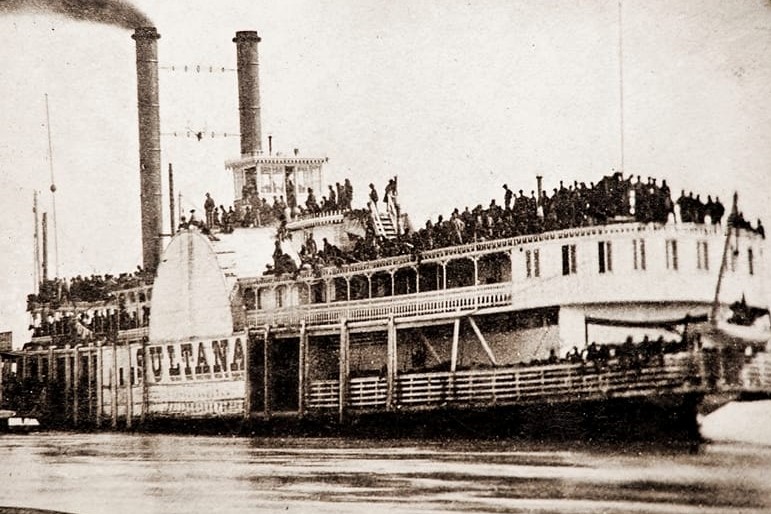The Sultana, loaded down with excess passengers. Courtesy | Facebook
The Sultana Historical Preservation Society is campaigning to open a museum in Marion, Arkansas and dedicate a commemorative coin to the 1865 Sultana shipwreck. It was the deadliest maritime disaster in United States history and killed nearly 1,200 people, including 67 Civil War soldiers from Hillsdale County.
The explosion of the Sultana affected Hillsdale so deeply that the city commemorated the event with a plaque downtown in 2001.
“We honor all who were on the Sultana for their courage and their service to their country,” the plaque reads.
A congressional bill to mint a commemorative coin to the Sultana disaster currently has 59 co-sponsors.
“Congress has the authority to mint two commemorative coins a year,” said John Fogleman, the president of the Sultana Historical Preservation Society. “It requires a supermajority, and thus far no coins have been approved. The bill will authorize the minting of a coin to commemorate this disaster. The surplus money would come to our museum.”
The commemorative coin would depict the Sultana itself, and the proceeds from the coin would go to the Sultana Historical Preservation Society.
“It’s like an action movie version of the Titanic,” Assistant Professor of History Miles Smith said. “As many people died at the Sultana as did on the Titanic.”
There were 2,200 people total on the Sultana when three of the steamship’s four boilers exploded in 1865, according to the Sultana Historical Preservation Society. About 1,195 passengers on the Sultana died, the American Battlefield Trust said.
“It was a huge deal at the time, but it got overshadowed,” Smith said. “It happened on April 27, but on April 9 the Army of North Virginia surrendered at Appomattox, and on April 14, Abraham Lincoln was assassinated. There’s all of this macro-political stuff going on.”
The Sultana itself was packed with people, and the explosions and subsequent fire caused most deaths.
“It was a steamship that was used to transport Union soldiers, and in the spring of 1865, it was overloaded,” Smith said. “The ship was designed to carry about 375 people, and it was carrying about 2,100 people. Some of the guys are in pretty rough physical shape because of the Army. There are women on board, too. Even if everything had gone perfectly well, it wasn’t a safe, healthy conveyance.”
According to Jennings, more than 258 soldiers from Michigan were on the Sultana, including Edwin Ford, a Hillsdale College student who served in Company D of Michigan’s 18th Volunteer Infantry.
“Ford joined in 1862, when Lincoln called for another 300,000 more volunteers,” Associate Professor of Management Peter Jennings said. “He attended Hillsdale College in 1856, the first year that Hillsdale College classes were taught in Hillsdale rather than Spring Arbor.”
Ford was taken prisoner on his way to Athens, Georgia, during Gen. William Tecumseh Sherman’s campaign and held at the Andersonville Prisoner of War Camp for about six months.
“He was finally rescued and thought the war was over and he would make it home,” Jennings said. “He got onto the Sultana, and he died.”
Sultana Historical Preservation Society members hope to establish a new museum in Marion, Arkansas, to better tell the story of the disaster.
“The Sultana deserves a real museum, worthy of the significance of the event,” Fogleman said. “Our goal is to educate the American public about this disaster and to let them know what happened.”
The first Sultana exhibit was in 2015 at Arkansas State University. According to Fogleman, the exhibit was successful and went to Marion, Arkansas, the closest city to the disaster.
“Marion is only five miles from the remains of the Sultana,” Fogleman said. “A lot of the rescuers’ descendants still live there.”
The original museum has attracted visitors from all 50 states and 14 foreign countries.
“Right now, the museum is in an old building with about 1,000 square feet,” Fogleman said. “We display what we can there, but it’s totally inadequate to display the artifacts that we have and also to tell the story of the Sultana — the bribery, the corruption, the political influence that led to the disaster. We also want to tell the story of the rescuers from Tennessee and Arkansas.”
The society hopes to raise $10 million to fund the museum. The campaign began in 2020, and the society broke ground on the museum’s site last fall, according to the society’s website.
“We’ve now raised $8.1 million of the $10 million,” Fogleman said. “If we reach $9 million by May 31, FedEx will donate that final million.”
![]()

